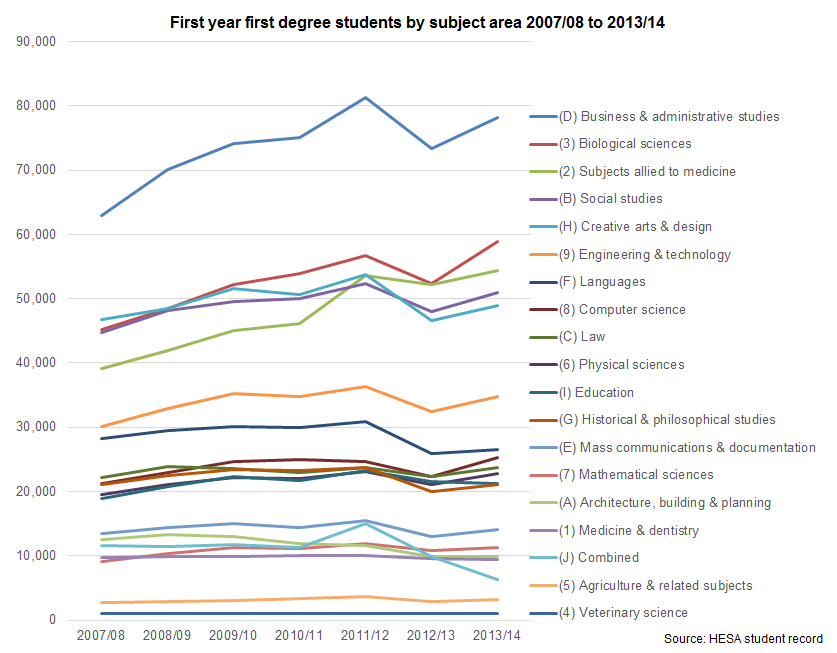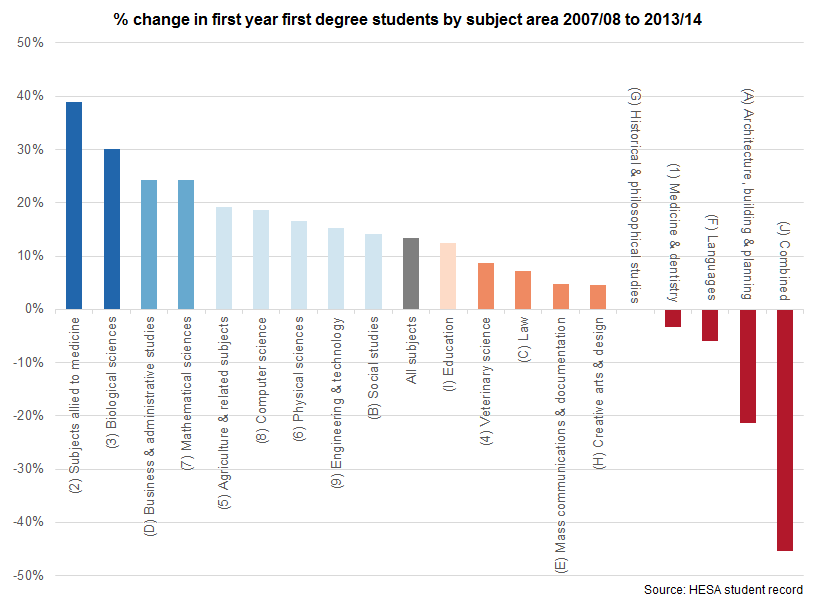Demand grows for Biology, Business and Maths degrees
HESA publication 'Students in Higher Education 2013/14' released today.
Data published today show that 521,990 students started first degree courses at UK HE providers in 2013/14. This is 5% higher than in 2012/13, but still 5% lower than in 2011/12 - the last year before the £9,000 fee cap was introduced. 15% of students starting degrees in 2013/14 were in the Business and administrative studies subject area.
7 year trends
The graphs and table below show the trends in first year first degree students by subject area. 2007/08 was the first year of the JACS2 subject coding system which is comparable with the current JACS3 system introduced in 2012/13.

Subjects allied to medicine and biological sciences saw the highest percentage growth in entrants over the seven years of the time series. The Combined subject area saw the largest percentage drop. The Combined subject area predominantly includes part-time Open University students who commence their degree courses without choosing a specific subject of study. Part-time entrant numbers experienced a significant drop in numbers following the changes to the funding system from 2012/13 (see Statistical First Release 210).

| First year first degree enrolments by subject area 2007/08 to 2013/14 | ||||||||
|---|---|---|---|---|---|---|---|---|
| Subject area | 2007/08 | 2008/09 | 2009/10 | 2010/11 | 2011/12 | 2012/13 | 2013/14 | 7 year % change |
| (1) Medicine & dentistry | 9695 | 9835 | 9925 | 9975 | 10105 | 9565 | 9375 | -3% |
| (2) Subjects allied to medicine | 39130 | 41895 | 45010 | 46060 | 53575 | 52135 | 54360 | 39% |
| (3) Biological sciences | 45255 | 48490 | 52150 | 53850 | 56650 | 52355 | 58870 | 30% |
| (4) Veterinary science | 970 | 950 | 980 | 1010 | 1055 | 1055 | 1055 | 9% |
| (5) Agriculture & related subjects | 2710 | 2860 | 3075 | 3320 | 3635 | 2900 | 3230 | 19% |
| (6) Physical sciences | 19515 | 21060 | 22195 | 21950 | 23155 | 21145 | 22730 | 16% |
| (7) Mathematical sciences | 9070 | 10340 | 11235 | 11155 | 11835 | 10770 | 11275 | 24% |
| (8) Computer science | 21300 | 22900 | 24655 | 24965 | 24740 | 22330 | 25290 | 19% |
| (9) Engineering & technology | 30155 | 32875 | 35220 | 34815 | 36305 | 32370 | 34725 | 15% |
| (A) Architecture, building & planning | 12580 | 13295 | 12930 | 11895 | 11640 | 9925 | 9900 | -21% |
| (B) Social studies | 44680 | 48235 | 49550 | 50050 | 52390 | 48070 | 50965 | 14% |
| (C) Law | 22130 | 23850 | 23585 | 22915 | 23670 | 22315 | 23710 | 7% |
| (D) Business & administrative studies | 62935 | 70025 | 74100 | 75010 | 81315 | 73330 | 78240 | 24% |
| (E) Mass communications & documentation | 13400 | 14360 | 15090 | 14470 | 15550 | 13010 | 14050 | 5% |
| (F) Languages | 28290 | 29485 | 30085 | 29920 | 30900 | 25930 | 26590 | -6% |
| (G) Historical & philosophical studies | 21160 | 22450 | 23360 | 23250 | 23735 | 20030 | 21110 | 0% |
| (H) Creative arts & design | 46725 | 48490 | 51600 | 50685 | 53775 | 46545 | 48880 | 5% |
| (I) Education | 18940 | 20765 | 22320 | 21745 | 23205 | 21595 | 21290 | 12% |
| (J) Combined | 11605 | 11480 | 11785 | 11230 | 15005 | 9900 | 6345 | -45% |
| Total | 460240 | 493650 | 518850 | 518280 | 552240 | 495275 | 521990 | 13% |
Subjects in detail
The two largest subjects within biological sciences are psychology and sport & exercise science, which saw increases in first degree entrant numbers of 26% and 34% respectively over the seven years.
![]()
![]()
Subjects allied to medicine is dominated by nursing, which saw a 73% rise in first degree entrants since 2007/08. This reflects the sector-wide change of nursing qualifications from DipHE to first degree level. Over the same period, entrants to complimentary medicines, therapies and well-being fell by 49%.
![]()
![]()
Languages was the largest subject area to see a fall in student numbers. This subject area includes English studies, which saw a 5% drop in first degree entrants.
![]()
There were also drops in the numbers of entrants for foreign language degrees. French fell by 25%, German by 34% and Spanish by 1%. Overall the number of entrants to modern foreign languages* fell by 16% between 2007/08 and 2013/14.
![]()
![]()
![]()
![]()
A table showing the equivalent data for all principal subjects can be downloadedhere.
Publication
Students in Higher Education 2013/14 is a downloadable publication which includes comprehensive data on students and qualifiers broken down by demographic and course characteristics, as well as data from the HESA Aggregate Offshore Record. Students in Higher Education 2013/14 is available to purchase now.
Further tables and graphs from Students in Higher Education 2013/14 are published as free online data tables and in the publication's introduction.
A schedule of HESA releases for 2015 can be found here.
Notes for editors
- Press enquiries should be directed to:
- Simon Kemp
- HESA Press Officer
- 01242 211120
- [email protected]
- 95 Promenade, Cheltenham, GL50 1HZ.
- In the above data 0, 1, 2 are rounded to 0. All other numbers are rounded up or down to the nearest multiple of 5.
- HESA student data is collected from all publicly funded Higher Education Providers in the UK, plus the University of Buckingham, which is a privately funded HE provider. The 2013/14 data covers 160 HEPs (130 in England, 8 in Wales, 18 in Scotland and 4 in Northern Ireland).
- HESA cannot accept responsibility for any inferences or conclusions derived from the data by third parties.
- More data on subjects of study can be found in Statistical First Release 210 and the publication introduction.
- Definitions of the terms used in this press release can be found here.
- Data intelligence notes can be found here.
- *'Modern foreign languages' comprises the following principal subjects:
- (R1) French studies
- (R2) German studies
- (R3) Italian studies
- (R4) Spanish studies
- (R5) Portuguese studies
- (R6) Scandinavian studies
- (R7) Russian & East European studies
- (R8) European studies
- (R9) Others in European languages, literature & related subjects
- (T1) Chinese studies
- (T2) Japanese studies
- (T3) South Asian studies
- (T4) Other Asian studies
- (T5) African studies
- (T6) Modern Middle Eastern studies
- (T7) American studies
- (T8) Australasian studies
- (T9) Others in Eastern, Asiatic, African, American & Australasian languages, literature & related subjects.
Ends

Press Officer
